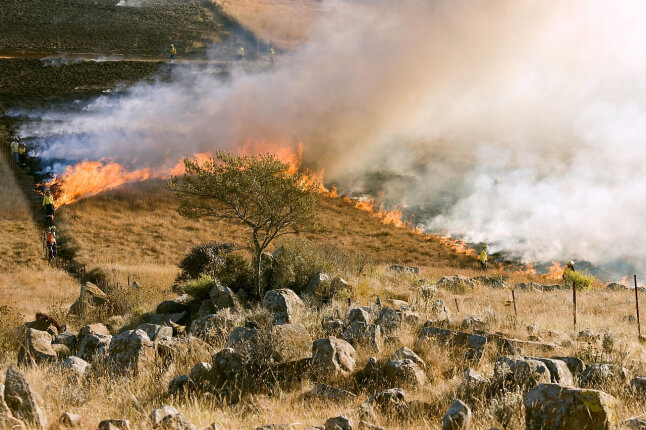News
A massive plume of smoke rises from wildfires burning in Gippsland, Australia. (AP file photo)
Key Takeaways
-
Harvard SEAS scientist Loretta Mickley warns that prolonged exposure to smoke from Australia’s recent wildfires could cause many premature deaths, similar to impacts seen after Indonesia’s 2015 forest fires.
-
Fine particulate pollution from wildfire smoke is linked to cardiovascular disease, pulmonary illness, and pneumonia in children, with health effects that can appear months after exposure.
-
Climate change is expected to make regions like Australia and the western U.S. hotter and drier, increasing the likelihood of severe, persistent fire conditions.
The recent massive wildfires in Australia have killed more than 30people and an estimated 1 billion animals, and burned 2,500 homes and millions of acres. And the human toll is expected to rise even after the blazes wind down. According to Harvard scientist Loretta Mickley, senior research fellow in atmospheric chemistry at the Harvard John A. Paulson School of Engineering (SEAS), long-term exposure to the smoke-filled air hanging over much of the country could lead to many premature deaths in Australia. In 2015, Mickley and a team of experts estimated that the air polluted by large forest fires in Indonesia had caused more than 100,000 premature deaths in that region. “The air quality across a large area of Australia has been very poor over a sustained amount of time, and the net health effects could last for several months to a year,” said Mickley, who spoke with the Gazette about her research.
Q&A
Loretta Mickley
Loretta J. Mickley, Senior Research Fellow in Chemistry-Climate Interactions at SEAS. (Photo courtesy of Eliza Grinnell/Harvard SEAS)
GAZETTE: What are the short-term versus the long-term effects of exposure to this kind of smoke?
MICKLEY: We do see acute health effects from fires. For example, someone may have an asthma attack from high levels of smoke in her neighborhood, or we might see an increase in hospital admissions for lung complaints or similar conditions. But what people don’t always realize is that the particles in the smoke can affect chronic conditions like heart or pulmonary diseases, and the current thinking is that the long-term health effects can be quite severe over a period of a year or even more. So someone may get a stroke next June in that region and not realize that it can be traced back to smoke exposure. I think that effect has not been widely reported with the fires in Australia.
GAZETTE: Can you talk about the findings from your earlier work around fires and health outcomes and if they might apply here?
MICKLEY: A few years ago we did a big project involving researchers from SEAS [the School of Engineering and Applied Sciences], the [Harvard T.H. Chan] School of Public Health, the Department of Earth and Planetary Sciences, and fire experts at Columbia University. Our team, led by Harvard principal research scientist Sam Myers, wanted to know about fires in Equatorial Asia, mainly in Indonesia where they have periodic strong smoke events lasting weeks. In that part of the world, many fires are deliberately set to clear the tropical forests in order to plant oil palm or other trees that are valuable in the marketplace. Farmers also use fire to reduce pests and clear debris in agricultural fields. In very dry years, which come periodically, these fires can get out of control; they escape, and the smoke can linger over a broad area for weeks at a time. And 2015 was particularly bad, with very heavy smoke comparable, I would say, to what at least some areas of southern Australia are experiencing now. Our team determined that the smoke that people in Equatorial Asia experienced in 2015 led to 100,000 premature deaths, with most of those deaths occurring in the one-year aftermath of the fires.
GAZETTE: Was there a main condition or disease that contributed to those deaths?
MICKLEY: For our study we relied on well-known, well-established relationships between particulate matter and health outcomes that people have developed over the years through long-term monitoring. The main diseases linked to particulate pollution are cardiovascular diseases like heart attacks and strokes, followed by pulmonary disease, and, in kids, pneumonia. At first glance, it looks like the levels of pollution experienced by some Australians because of the recent fires may be on par with what we saw in some areas of Equatorial Asia in 2015. We have not yet done any quantitative analysis, though. And Australia is much less densely populated than Equatorial Asia, so we would expect fewer deaths.
GAZETTE: In your research, did you find there was a particular length of time someone needed to be exposed to this kind of poor air to suffer the long-term health effects?
Someone may get a stroke next June in that region and not realize that it can be traced back to smoke exposure.

MICKLEY: The longer you are exposed, the more likely you are to get a health impact. In Equatorial Asia, the smoke lasted for weeks. In our study, we averaged exposure over the year to determine the health impacts over the following year.
GAZETTE: How long does it take the air to clear from these kinds of events?
MICKLEY: That’s a good question. For much of the world, air quality returns within days to normal conditions because the wind will carry away the plumes, and the fire is dead. However, if there is peat in the soil, which you often see in tropical forests, that peat can smolder for weeks. So in these areas the fires need not just to be controlled, but actually extinguished. Then, the smoke will die down pretty quickly.
GAZETTE: Do you think these fires in Australia foreshadow the kinds of fires we could see in this country in the future?
MICKLEY: Yes, I do. If you look at the history, Australia and other areas like the western U.S. have gone through large climate changes in the past, maybe 500 to several thousand years ago. These are what we will call natural variations in climate, sometimes accompanied by very severe droughts. I was recently looking at records of charcoal in lake sediment, which are made by bringing up cores of dirt from the bottom of a lake. These records provide a sense of when fires occurred because you can see layers of charcoal indicating that there was regional fire at that time. In lake sediment from Tasmania, an island state off of Australia’s southern coast, it looks like there was tremendous fire activity occurring periodically over the last 2,400 years. But the authors of the paper examining these records stress that just because intense fire activity comes naturally from time to time, human-caused climate change could also bring back some of these same conditions experienced in the past. But this time there may be no return to normal conditions, at least not for a long time. That is, as we pump more carbon dioxide into the air, and temperatures rise, some regions, particularly Australia, are expected to get much drier, and these weather conditions will likely persist. Carbon dioxide lasts a very long time in the atmosphere — centuries, so things don’t look good. The increase in temperatures alone evaporates the moisture in the soils. Combine that with a drought, and you have even drier conditions. This dryness turns the vegetation into a fuel that can feed the fires very well, as we’ve seen.
Wildfire research developments
Follow the evolution of wildfire research at Harvard SEAS at this link.
Topics: Climate, Environment, Research, Wildfire
Cutting-edge science delivered direct to your inbox.
Join the Harvard SEAS mailing list.
Scientist Profiles
Loretta J. Mickley
Senior Research Fellow in Chemistry-Climate Interactions
Press Contact
Leah Burrows | 617-496-1351 | lburrows@seas.harvard.edu





